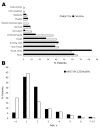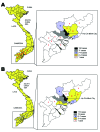Epidemiologic and virologic investigation of hand, foot, and mouth disease, southern Vietnam, 2005
- PMID: 18217559
- PMCID: PMC3375788
- DOI: 10.3201/eid1311.070632
Epidemiologic and virologic investigation of hand, foot, and mouth disease, southern Vietnam, 2005
Abstract
During 2005, 764 children were brought to a large children's hospital in Ho Chi Minh City, Vietnam, with a diagnosis of hand, foot, and mouth disease. All enrolled children had specimens (vesicle fluid, stool, throat swab) collected for enterovirus isolation by cell culture. An enterovirus was isolated from 411 (53.8%) of the specimens: 173 (42.1%) isolates were identified as human enterovirus 71 (HEV71) and 214 (52.1%) as coxsackievirus A16. Of the identified HEV71 infections, 51 (29.5%) were complicated by acute neurologic disease and 3 (1.7%) were fatal. HEV71 was isolated throughout the year, with a period of higher prevalence in October-November. Phylogenetic analysis of 23 HEV71 isolates showed that during the first half of 2005, viruses belonging to 3 subgenogroups, C1, C4, and a previously undescribed subgenogroup, C5, cocirculated in southern Vietnam. In the second half of the year, viruses belonging to subgenogroup C5 predominated during a period of higher HEV71 activity.
Figures





References
-
- Grist NR, Bell EJ, Assaad F. Enteroviruses in human disease. Prog Med Virol. 1978;24:114–57. - PubMed
-
- Stanway G, Brown F, Christian P, Hovi T, Hyypia T, King AMQ, et al. Family Picornaviridae. In: Fauquet CM, Mayo MA, Maniloff J, Desselberger U, Ball LA, editors. Virus taxonomy: eighth report of the International Committee on Taxonomy of Viruses. San Diego: Elsevier Academic Press; 2005. p. 757–78.
-
- Schmidt NJ, Lennette EH, Ho HH. An apparently new enterovirus isolated from patients with disease of the central nervous system. J Infect Dis. 1974;129:304–9. - PubMed
Publication types
MeSH terms
Substances
Grants and funding
LinkOut - more resources
Full Text Sources
Miscellaneous
